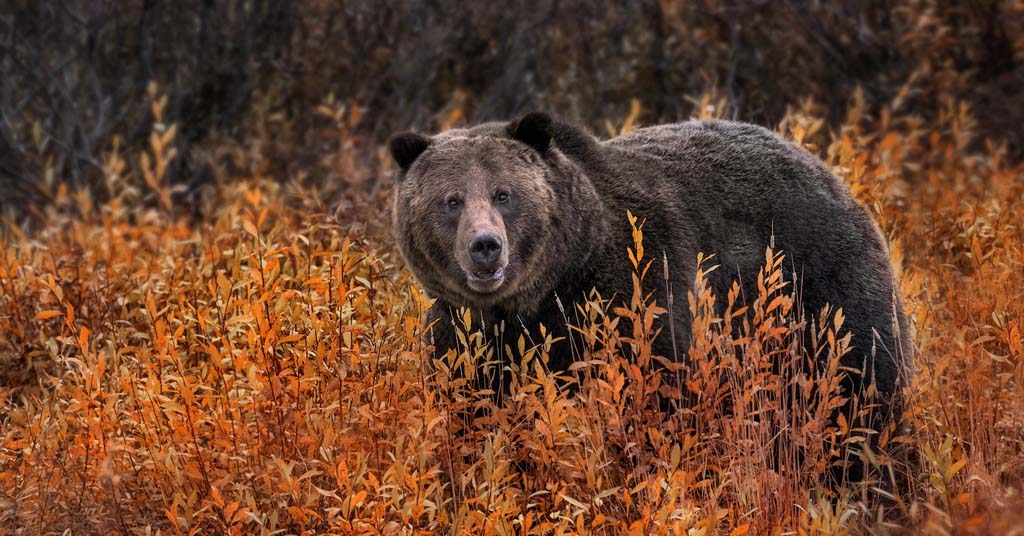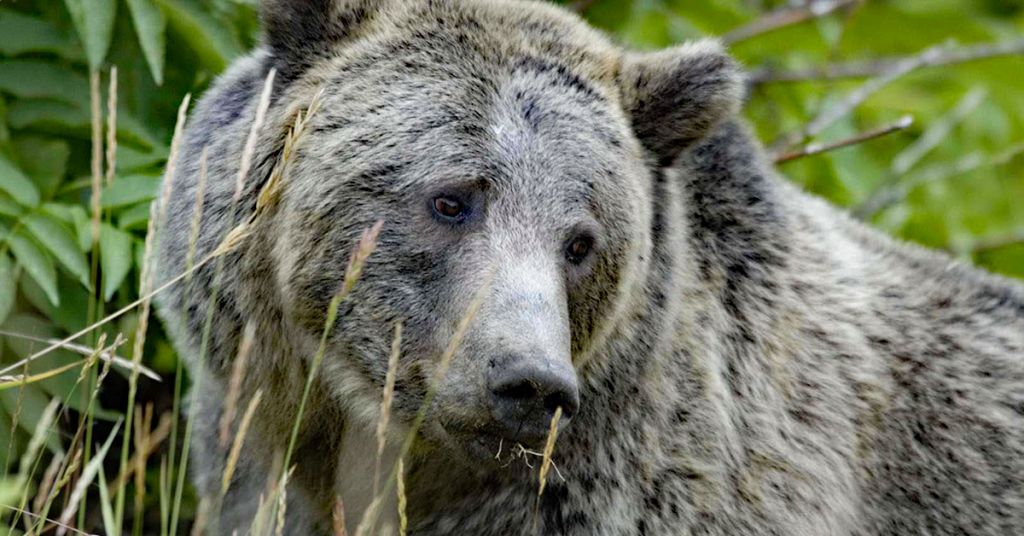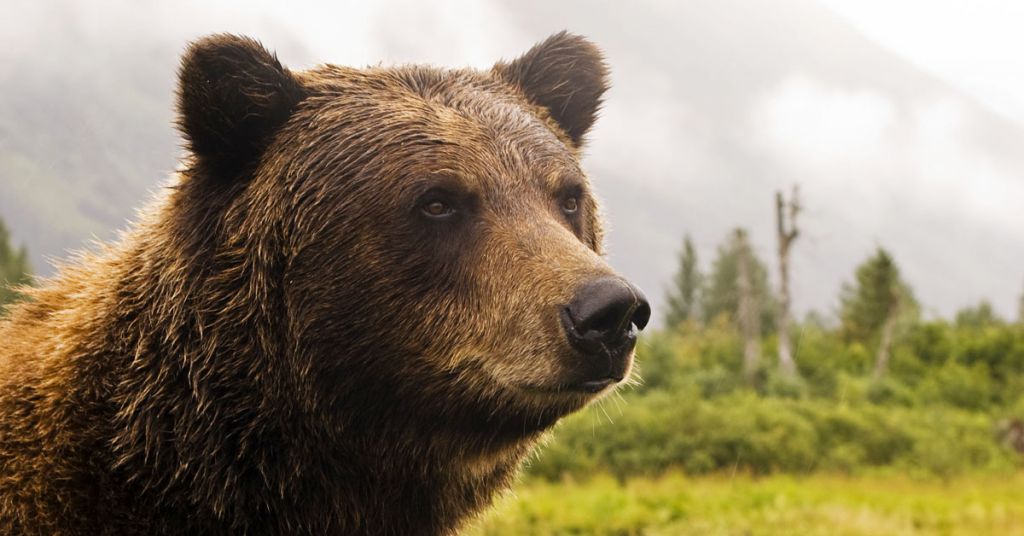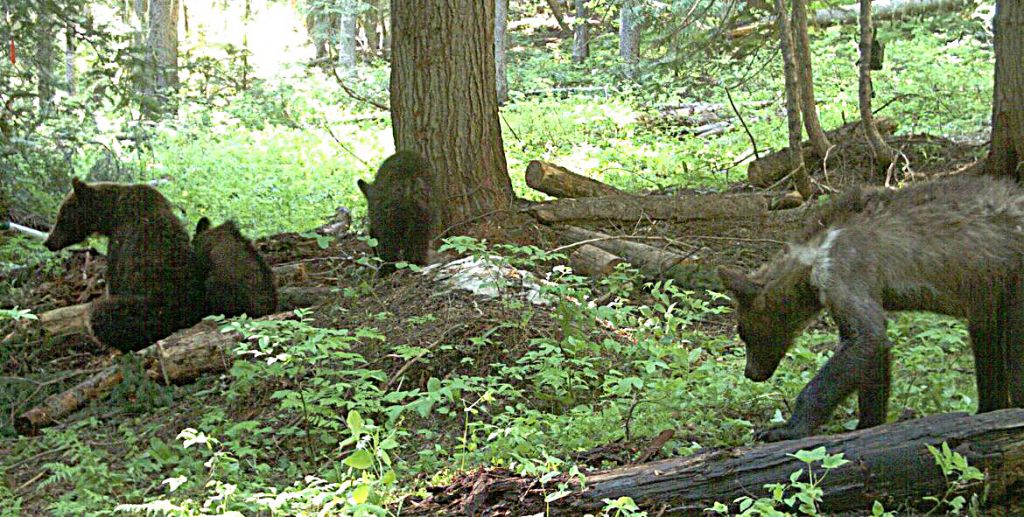Discussions about bringing back brownies are heating up … just like they did 30 years ago

Laying in wait: It’s been more than 25 years since the last confirmed grizzly sighting in Washington’s North Cascades. Plans are afoot to change that. File photo: Lisa Hupp/USFWS
By K.C. Mehaffey. November 9, 2023. You’ve probably seen the headlines—“U.S. drafts plan to bring grizzly bears back to Washington’s North Cascades.” That was from a Nov. 4 Washington Post story.
“Should the North Cascades Get Their Grizzlies Back? Now’s Your Chance to Weigh In.” Backpacker ran that one in October.
The dramatic pronouncements have been a reaction to the latest efforts by the U.S. Fish and Wildlife Service to reintroduce the apex predator into the Cascade Range.
The articles echoed a National Geographic story titled “Should Grizzlies Be Restored to the North Cascades?” That one was from 2014.
Wait, almost a decade ago?
In fact, the effort to bring grizzlies back to the Cascade Range—part of their historic range—goes back to the 1990s.
So what, if anything, makes the current push any different?
Tortured history
It’s been almost half a century since grizzly bears in the lower 48 states were listed as threatened under the Endangered Species Act, and federal agencies have yet to finalize a recovery plan for the North Cascades ecosystem.
Comment periods and public meetings with government agencies have come and gone over the last 30 years, always ending in a stalled process.
In Okanogan County, Wash., where a good chunk of the proposed grizzly bear recovery zone is located, Andy Hover remembers his dad, an Okanogan County commissioner, being opposed to the boundaries of the North Cascades recovery zone, which encompasses Winthrop, the tiny north-central Washington town where they live.
Now an Okanogan County commissioner himself, Hover took on his father’s worry about what will happen if grizzlies are reintroduced and protected by federal laws that he thinks don’t take into account the impacts to small communities.
“It’s still a sore spot,” Hover says of being inside the proposed recovery zone.

Here be bears. Maybe. Map: USFWS
On the other side of the Cascade Range, Mitch Friedman, executive director of Conservation Northwest, recalls that a grizzly bear was featured on his letterhead when he established the organization from Bellingham, Wash., in 1988.
“One of the main reasons I founded the group was to advocate for grizzly bears” in the North Cascades, he tells Columbia Insight.
Over the decades, Hover and Friedman have seen plans to recover grizzly bears in their backyards move forward, then step back as new presidents were elected and new administrations took hold.
In November 2022—more than two years after many thought a federal effort to reintroduce grizzly bears in Washington had been shelved for good—the USFWS and National Park Service announced plans to prepare an environmental impact statement (EIS) to, again, consider restoring grizzly bears in the region.
A draft EIS was released in September and public comments are due by Nov. 13.
This on-again, off-again approach to grizzly bear recovery in the North Cascades has some people wondering if a federal plan to reintroduce the iconic yet much-feared bear will ever be realized in one of the wildest and most pristine habitats left in the Pacific Northwest.
New management language
This year’s draft EIS has a new twist—use of the 10(j) rule.
Under section 10(j) of the Endangered Species Act, federal agencies can designate a population of threatened or endangered species that is geographically isolated from other populations as “experimental.”
That’s what the federal government is now proposing for reintroducing grizzlies in Washington under its preferred alternative in the draft EIS.
The designation gives agencies and local communities new options for dealing with problem bears.

County Commissioner Hover. Photo: Okanogan County
“If adopted, management tools could include the deterrence, relocation, or removal of animals involved in conflict,” says the National Park Service.
Without the designation—which is another alternative in the draft EIS—the bears would be managed as a threatened species and could only be taken (i.e., killed) under specific circumstances, including “defense of life; federal, state or Tribal scientific or research activities; or removal of grizzly bears involved in conflicts by authorized federal, state, or Tribal authorities,” according to the draft EIS.
Under both alternatives, federal agencies would relocate between three and seven bears each year for five to 10 years to establish an initial population of 25 bears. The long-term goal is to end up with 200 bears in the next 60 to 100 years within the 9,800-square-mile recovery zone.
The agencies’ preferred alternative splits Washington into three zones.
Bears on private, state or local government lands within the original recovery zone—and throughout most of the rest of the state—would be managed as a “nonessential experimental population.” That gives agencies more tools, like relocating bears preemptively to prevent conflict, or issuing lethal take permits to private landowners when they’re an ongoing threat to human safety, livestock or other property.
Bears on federal lands in the recovery area would be managed as other species that are threatened under the ESA—with a much higher bar for dealing with conflict bears.
A new zone—which includes national forest lands outside the recovery zone—would be managed to accommodate the bears’ natural movement or dispersal.
“It feels different this time”
Representatives from environmental organizations that have pushed for reintroducing the grizzly bear from the beginning say they’re optimistic that this time, the process will be completed and a plan to restore grizzly bears will move forward.
“I think at this point we’ve got an administration that’s a little more enlightened than we’ve had in the past. I think it’s going to be a go, for sure,” says Ric Bailey, a North Cascades Conservation Council (NC3) board member.

Ready for bear: Mitch Friedman founded Conservation Northwest in 1989. Photo: Conservation Northwest
Bailey says he expects to see a final EIS within a year, and reintroduction to begin a year after that.
Although NC3 is happy about the proposal to reintroduce grizzlies, Bailey says the group has several concerns about the government’s preferred alternative.
“First of all, we’d like to see the bears reintroduced from a stable population, not a population that’s already in trouble,” he says.
Also, predators that are trans-located into a new area tend to experience high mortality, and his organization thinks more precautions could be taken that would lead to fewer deaths of relocated bears.
The EIS should also consider the connectivity issue, so that bears in the North Cascades aren’t as isolated from populations in British Columbia, northern Idaho and Montana, he says.
NC3 is also disappointed that the preferred alternative designates bears outside of the federal lands as experimental. Bailey says the management guidelines are vague, and there’s too much potential for property owners to kill bears they just don’t want on their land.
But to Friedman, director of Conservation Northwest for 35 years, the use of section 10(j) brings more people on board, making it more likely that relocation will actually happen this time.
“I’m optimistic, both because the agencies seem very focused and determined, and because they’ve taken a very sensible approach,” he says.
Using the 10(j) rule provides more management flexibility, which means more support—or at least less opposition—to reintroduction.
“It feels different this time,” Friedman says. “We’ve seen wolves not only return after a long absence, but we’re getting much better at coexistence with them. The fisher reintroduction has been successful. Wolverines continue to spread, which excites everybody,” he says. “I think we’ve found ways to move past the old stalemates to address concerns, do quality work on the ground and move forward.”
Opposition firm, but …
Hover, the Okanogan County commissioner from Winthrop, says he’s still against reintroduction, but the 10(j) rule makes it more palatable.
“I don’t want them here, period,” he says, pointing to news of grizzly bear attacks in Montana, which is far less populated than Washington.
He says the draft EIS doesn’t consider the fact that Montana has far more land and far fewer people than Washington.
“Will conflicts be exponentially greater in Washington due to our smaller land mass and larger population? Montana has only 1.8 million people; we have 8.5 million,” he says.
Hover thinks even bears that are released deep in the wilderness will follow rivers and streams to lower elevations looking for food.
But the designation as an experimental population will at least enable local people to manage them, he notes.
As for whether the process will stall again, Hover says each time it resurfaces, the pendulum swings farther toward reintroducing bears, and it never swings back far enough the other way.
“I would like to say, no, it’s not going to happen. But I think it’s probably inevitable that grizzly bears are going to be here. The handwriting is on the wall,” he says. “I don’t think it matters if a majority of people in the local jurisdictions say they don’t want it. I think they’re going to do it anyway.”
Montana success inspires confidence
Proponents of restoring grizzlies to the North Cascades say they’re not sure why it’s been such a struggle here, while agencies were able to reintroduce grizzlies in Montana’s Cabinet-Yaak ecosystem, starting 30 years ago.
Friedman suggests that the agencies looking to restore grizzly bears are based in the Rocky Mountains, and resources may have been prioritized there.
Perhaps more importantly, he notes, “Our observation is that, the less familiar people are with grizzlies, the more uncomfortable they are” with reintroducing them.
In Montana, people were already used living with grizzly bears.
Wayne Kasworm, a U.S. Fish and Wildlife biologist for the grizzly bear recovery program, has worked closely with the reintroduction program in the Cabinet Mountains, as well as recovery in other parts of the West. He says the proposal to reintroduce grizzlies in the North Cascades is only the second time his agency has proposed relocating grizzlies to augment a population.
Without transplanting bears, the population in the North Cascades—if there is one—is too small to recover on its own, he notes. The last confirmed Cascades sighting on the U.S. side of the border was in 1996.
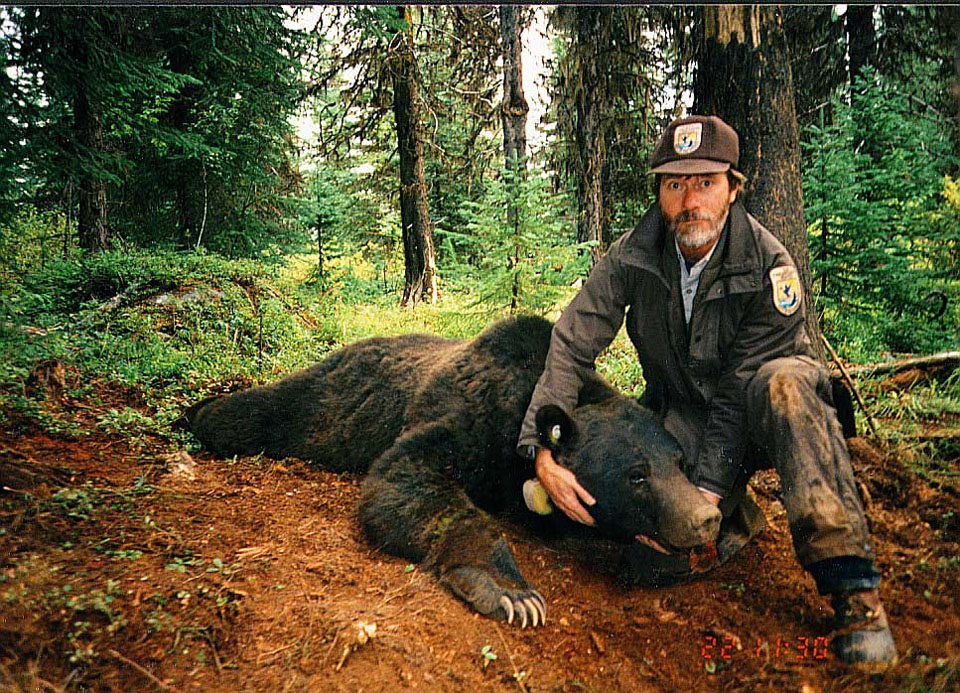
Transfer portal: Wayne Kasworm with adult male grizzly captured as a research animal in the Yaak River drainage in Montana. Photo: USFWS Mountain-Prairie
Kasworm attended a Nov. 3 public meeting in Winthrop where he talked about the Cabinet-Yaak ecosystem and the success of reintroducing grizzlies there.
“Certainly, it was controversial to start with. No doubt about it,” he says. “As a person who was there proposing it, there were some rough moments.”
But now, he says, press releases about the relocated bears sometimes don’t even make the local news.
Kasworm says they’ve learned a lot about how to reduce the potential for conflict.
Just as in the Cabinet Mountains, agencies would relocate bears to the North Cascades from areas with similar food sources. They’d seek out bears from areas where they already eat mostly roots and berries, and are less accustomed to eating game species or anadromous fish.
In the Cabinet Mountains, 22 bears have been relocated in the last 30 years, according to Kasworm.
None have attacked people, he says.
Eight have left their recovery area; three of those returned to their home areas. Of the five that did not, two died of natural causes; one died of unknown causes; one was hit by a train; and one was shot and killed by a resident who claimed the bear was eating their garbage. An examination found no garbage in the bear’s stomach, and the person was found guilty of illegally taking a threatened species, says Kasworm.
Grizzly gains
According to a USFWS five-year status review of grizzly bear recovery, significant strides have been made in other recovery zones to restore grizzly bears in the 48 years since they were listed as threatened.
Completed in 2021, the review says an estimated 700 to 800 grizzlies occupied less than 2% of their former range in 1975. They could be found in only a handful of ecosystems in the West—including the North Cascades.

Doing well: Yellowstone griz. Photo: Terry Tollefsbol/NPS
By 2019, the total grizzly bear population in the lower 48 states more than doubled to at least 1,913 individuals, and their territory expanded to occupy about 6% of their historical range.
In the Cabinet-Yaak ecosystem, reintroduction helped boost a population of grizzlies that had fewer than 15 individuals to between 55 and 60 bears, “almost exclusively through augmentation and reproduction from those individuals,” the status report says.
Despite a complete lack of recovery in the North Cascades, the status report says that threats to grizzly bears in the continental United States have declined, and in some cases, are ameliorated.
“Given the current levels of resiliency in four out of six ecosystems, the high resiliency of the [Greater Yellowstone ecosystem] and [Northern Continental Divide ecosystem], and the lack of significant, imminent stressors, we believe that the grizzly bear in the lower-48 States currently has sufficient ability to withstand stochastic and catastrophic events, and to adapt to environmental changes,” the status review says.
It concludes that grizzlies are still likely to become endangered throughout all or a significant portion of their range, but that the current risk of extinction is low.
What could halt the process again?
Rep. Dan Newhouse, a Republican congressman whose district includes portions of the North Cascades ecosystem for grizzly bears, has long opposed reintroducing the bears.
He’s blasted federal agencies for resurrecting an issue that he says had been resolved.
In addition to securing more public meetings, Newhouse introduced legislation in October that would require Secretary of the Interior Deb Haaland to withdraw the draft EIS and the proposed 10(j) rule for grizzlies in the North Cascades.
While the bill didn’t go anywhere, on Nov. 3 the U.S. House of Representatives did pass H.R. 4821, the Department of the Interior, Environment, and Related Agencies Appropriations Act for Fiscal Year 2024.

Opposed: Rep. Dan Newhouse. Photo: Office of Dan Newhouse
Along with annual funding, the bill includes many controversial measures—like repealing the Biden administration’s Waters of the United States regulations, requiring oil and gas lease sales and prohibiting the Environmental Protection Agency from requiring permits for livestock emissions.
The bill also would prohibit reintroduction of grizzlies in the North Cascades and direct Haaland to reissue a final rule delisting the Greater Yellowstone ecosystem population of grizzly bears.
The bill is being sent to the Senate, but with a Democratic majority, it’s unlikely to pass without significant revisions.
Even Newhouse sees the process ending in reintroduction this time.
After attending a public comment session in Okanogan on Oct. 30, he wrote in an update to constituents, “While I’m grateful we were given the chance to speak out, it seems that the concurrent release of the draft EIS and the 10(j) proposal means that NPS and USFWS have already made up their minds and plan to bring the grizzlies to our communities.”
Federal officials countered that notion at a Nov. 3 public meeting in Winthrop.
“I’d like to emphasize that we’re here to listen,” Don Striker, superintendent of the North Cascades National Park, told a crowd of about 200 people.
Striker said a decision hasn’t been made, and pointed to use of the 10(j) rule to demonstrate that officials had listened to comments from the last EIS process, and changed their proposal based on public input.
“I’ve already modified my opinion based on comments” from meetings earlier in the week, Striker said.
About 50 people signed up to speak at the Winthrop meeting. Many addressed issues that had been previously raised.
Opponents said the habitat has changed since grizzly bears were last in the Cascades, and so have the food sources. Many pointed out that there are fewer deer now, and bighorn sheep no longer roam the landscape.
Opponents worry there won’t be enough food for the grizzlies, and fear for their own safety, as well as their domestic animals and their livelihoods.
Dave Schulz, a Twisp, Wash., orchardist and former Okanogan County commissioner, said black bears already damage his orchard, for which he receives no compensation from the state. He said if grizzlies are reintroduced, the new local policy will involve the three S’s: “Shoot, shovel and shut up.”
Proponents said people coexist with grizzly bears in many other parts of the United States, and in those places, residents overwhelmingly support the grizzly’s right to exist there.
They agreed that reintroducing bears would bring new safety risks, but said those risks can be avoided, and are much smaller than those people live with every day from gun violence and driving automobiles.
A final EIS and Record of Decision are expected next year.




